Found this on YouTube:
Thought this is worth sharing on a meat related website.
Found this on YouTube:
Thought this is worth sharing on a meat related website.
Let me start with the Bratwurst which is translated “Frying Sausage” and would include any of the fresh sausages we put on the grill. I know we refer to Bratwurst or Brats to the fresh German style sausages we became familiar with, ground or chopped meat, usually includes pork, seasoned with salt and spices, stuffed into 1 inch diameter hog casings and linked about 6 inches long as our standard. Many companies broaden their assortment by adding whatever they can think of and/or their customers will buy. So you can find beer brats, jalapeno brats, even brats with cherries in them.
For a nice variety of the basic “Bratwurst” let’s go to Franken region in the northern part of Bavaria which I consider the German Bratwurst mecca, there the Bratwurst is make from pork or veal or a combination thereof, some even include beef.
I introduced these local specialties on my Bavaria4U pages in the “Bratwurst Mecca Franken” post.
Many other local type Bratwurst are served here and in the surrounding regions in restaurants and always at the local beer festivals.
There are many other examples of fresh sausages.
Here we can include all types of Italian sausages, fresh Polish Kielbasa and all the other like a Hungarian style Brat and the country style brats which used to be a favorite here in Michigan back in the 70’s. The fresh Mexican Chorizo and many other ethnic types like the Swedish Potatis Korv, English Bangers also belong here, I would also add the Cevapcici which is home to the Balkans or the whole area which used to be Yugoslavia.
Included in this category is the ever popular Breakfast Links or Sausage and also the Sausage patties made out of bulk pork sausage or sausage rolls or chubs.
As fresh sausages will not have a long shelf life many manufacturers will pre-cook their product to extend the “Best before” dates or they also can be frozen.
If you would like to start to make your own, there is a very low cost way to try it, it is the Sausage patties mentioned above or you could roll it in the form of the Cevapcici. Basic meat to use would be pork but you could use any type of meat from Turkey to Chicken, Buffalo, Alligator and if you are a hunter, part of the deer you were lucky enough to bag. Just to mention some of the meats will be very lean and dry out if you overcook them, that is why we add pork trimmings when we make deer sausage.
For those of you that like it spicier you could try our Jalapeno Cheese Patties.
Once you tried your hand in “Wurst making” (for Luncheon Meats you can try our Wurst Base Recipe) and you like it, it is time to decide if you want to invest into the equipment and go into it deeper or even try sausage making afternoons with your friends.
There are three post about this subject on this blog about the “WHY“, “Making Wurst” and “Why waste my time to make sausage”
Here are links to some of the equipment we use and will get the job done.
I made it a point today to read some of the negative reviews of the Jaccard Tenderizer on Amazon.
Let me work on this step by step.
In conclusion: Use this piece of equipment the way it is intended and you will not want to miss it.
Abuse it and you will throw it out soon!
To determine this you have to answer a few other questions.
If you answer yes to a couple of these questions, keep on reading, as buying a meat grinder might be right for you!
To control what goes into your ground beef. Buying beef roasts on sale, cutting them up and grinding them will assure you that you know exactly what is in your ground beef, but unless you get a very good deal on the meat, it will, in general, not save you much money.
I am a stickler when my family wants some Steak Tartar and do not trust many meat markets to grind it for me, so I will buy a whole Beef Sirloin Tip, seam it out, cut the meat I need to grind for my Tartar and cut the rest into pieces for Beef Stroganoff, Senffleisch, Goulash or Stew and, after using my Jaccarder, into pieces for Shish-Kebobs. This drastically limits contamination of the meat that we eat raw.
On the other hand, did you ever add ground pork to your ground beef? It is worth a try. It will make the consistency of your hamburger more delicate, refines the taste and saves you money.
We mix 50% ground beef with 50% ground pork to improve many dishes like stuffed peppers, stuffed cabbage, meatloaf, meatballs, Salisbury steak and even hamburger patties, we even make our own “Hamburger Helper” dishes out of ground pork. Many older meatloaf recipes actually call for a meat mixture of Beef, Pork and Veal.
Now buying ground pork at the market is almost even in price with ground beef and will just enhance your ground meat experience.
On the other hand places like Gordon Food Service sells two boneless Pork Boston Shoulder Butts in a vacuum package at today’s prices for $1.29 with the total weight of 16 to 18 pounds. (This is a 2021 update: You still can find pork shoulder butts on sale for a very decent price, so if you find them you can still save quite a bit of money, if you compare it to the ground pork price in the meat counters.)
If you have a way of processing these at home you could save a nice amount of money!
Read my post on what you can use this piece of meat for.
Consider also that boneless pork loins are nowadays frequently on sale for $1.69 in our local supermarkets or warehouse stores, so grinding even these will save you over $1.00 per pound to ground beef.
Meat Grinders come in many forms and sizes, manual or electric or as accessories to other machines. In my consideration many of these smaller machines or accessories are toys.
After selling my meat store I still wanted to play around with meat somewhat, after all if you are in the business most of your life it is in your blood. So with the help of this wonderful world wide web I researched this topic and as I did not know how deep I wanted to immerse myself into this “hobby”, I decided to start on a smaller scale and buy the meat grinder on the left.
This machine has no problem to grind 20 pounds for one of my regular meat sessions. So a lot slower and less powerful than the machines I was used to in the store it is still adequate for this job.
Grinding 2 Pork Butts, which I do about every two month, is usually enough for 4 rolls of Lunch Meat with some taste variations some ground pork to blend with ground beef and to mix up a couple of pounds of Pork Sausage Patties. In the end this let’s us have some excellent lunches and meals and keeps over $50.00 in my pocket every time I do it. Spending less than 1 hour on it, including cleaning the grinder and a couple of stainless steel bowls. Within two sessions the money I spend on the grinder was recovered.
As a hunter you will be able to grind your meat together with some fatter pork and make your own chili meat or Sausage Patties, just make sure that all meat is cut small enough and completely thawed. There is a stuffing horn with it, but in my opinion you are better of with a dedicated meat stuffer for this job. Please read my post on Sausage Making Equipment.
The equipment featured here is the equipment we use.
If we link to Amazon.com and you buy through this link we receive a small commission.
There is at this time no commission coming to us from sales from any of the other businesses mentioned in our blogs.
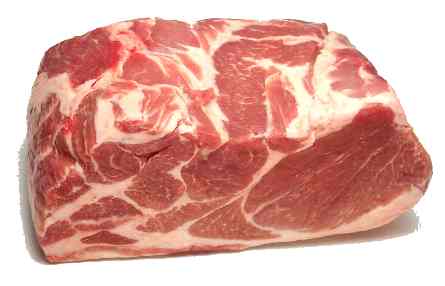 The Boston Butt is the pork shoulder, weighs 6 to 9 pounds, can be bought bone in or boneless and is right now very affordable – look for sales in stores.
The Boston Butt is the pork shoulder, weighs 6 to 9 pounds, can be bought bone in or boneless and is right now very affordable – look for sales in stores.
The cheapest way to buy is 2 pieces vacuum packed at about 17 to 18 pounds total weight.
When buying the bone in variety at a supermarket sale, if you don’t want to use the whole piece as a roast or for pulled pork, have the meat cutter slice off 4 pork steaks, remove the rest of the bone and grind the meat or lean it out for stew. Pork stew will make an excellent Hungarian Style Goulash.
Please note, that there is a gland in the fat part of the meat which will add bitterness to the ground meat if not removed before grinding.
If the shoulder is boneless you can cut the lean part into a roast, boneless pork steaks, stew meat and grind the rest.
For a few of the many possible recipes visit ingeskitchen.com.
|
Buy a Meat Grinder – Yes or No? |
Getting back to the ground meat.
If you have a grinder, grind the butts, after removing the gland, and add it to ground beef. It will make the consistency of your hamburger more delicate, refines the taste and saves you money.
We mix 50% ground beef with 50% ground pork for many dishes like stuffed peppers, stuffed cabbage, meatloaf, meatballs, Salisbury steak and even hamburger patties, we even make our own “Hamburger Helper” dishes out of ground pork.
This 50/50 mix alone will save 70 to 80 cents per pound on your ground meat or about $1.50 if you use 100% ground pork in your dishes
Using ground pork to make lunch meat like in our base recipe (pictured below) can save you $4.00 or more over your deli counter price at a better quality with less fat and without preservatives and fillers. Please make sure that you leave at least 10% of fat on it as your sausage will not be juicy enough without it.
The equipment featured here is the equipment we use.
If we link to Amazon.com and you buy through this link we receive a small commission.
There is at this time no commission coming to us from sales from any of the other businesses mentioned in our blogs.
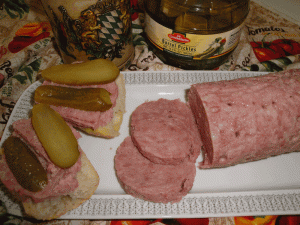
You might have read my post on the “WHY to make your own Wurst” and tried my low cost easy recipe on ingeskitchen.com to start making your own lunch-meat and decided that you would like to get into it a little deeper.
I will introduce the machines and gadgets I started out with in a smaller way after I sold my store and the machines I use now.
The first item is a decent gram scale which I bought from Harbor Freight for weighing some ingredients and then to weigh up the meat, a halfway decent postal scale should do the trick to get you started.
As many of my recipes use ground pork as the main meat ingredient it is a fact that you can buy Boston Pork Shoulder Butts a lot cheaper than ground pork. So if you are serious about getting into grinding our own – buy a meat grinder.
I started with the ½ HP grinder picture below on the left, which I still own and use for smaller amounts of meat, as it is, from the size, pretty easy to clean in a kitchen sink.
This machine is powerful enough to grind a couple of Pork Butts. It comes with 3 cutting plates which is under normal circumstances all you need.
I like it when I have to grind meat only one time, as the plunger is not tight enough to run the meat a second time. Please note that this is my opinion as a retired butcher used to large and powerful machines.
I tried using the stuffing tubes with mixed results (takes way too long to get the job done!).
Make sure that your meat is cut small enough and not frozen. The holes on the coarse plate that comes with it are big enough to make a coarser Polish Kielbasa.
Now I use the grinder linked above on the right, which I bought from Butcher & Packer last year.
This is a nice powerful meat grinder which I use for the few fundraiser I do during the year, like at our church and the American Legion Post I belong to.
It will easily grind the 200 pounds we did at the last fundraiser.
The plunger is tight enough to push the meat in to grind it a second time to make it finer, like hamburger and when I make Steak Tartar or grinding meat fine to run it the second time with lean pieces of meat through the coarse plate for my Polish Kielbasa.
Stuffing sausage with it is a pain in the neck and I prefer a dedicated sausage stuffer which I cover next.
I started with the 5 pound LEM Sausage Stuffer which is linked on the left below. It is a nice little vertical stuffer which will do the job easily and, from the size, stuffing can be done by one person. I saw this stuffer with metal and plastic gears on top and made sure that the one I bought had metal gears.
I recommend this one to start out in your endeavor.
Before I go any further I have to talk about my experience and my preference.
If you look at the two stuffers pictured below you will see that one is vertical and the other one horizontal. Most stuffers sold are like the one on the left which is good when the stuffer is smaller. Now I need you to image yourself standing at a working height table (like a kitchen counter), which is the most comfortable height for your left hand to work the stuffing horn (anything lower will cause your back to ache after a while, especially in my retirement age). Now stand at a table and figure that the hand crank is centered about 12 inches higher and as it is about 8 inches long the total height of cranking at the small 5 pound stuffer is 20 inches and you have to crank it away from you while taking care of the stuffing with your left hand. Bottom-line is that can be done.
Now raise your hand up another 10 inches, that the center of the crank is 20 inches high and try the same again, this is what it would be like on a 15 pound vertical stuffer.
 |
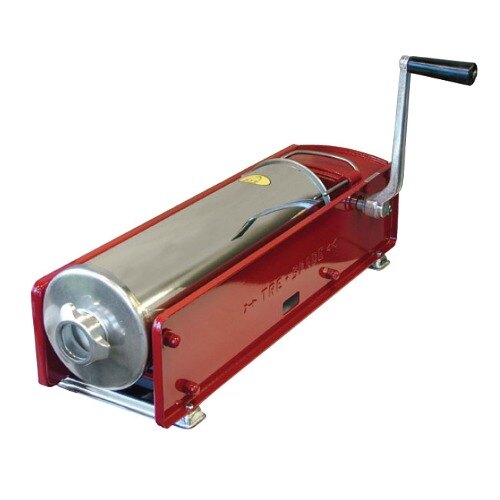 |
Now on the horizontal stuffer you are cranking at about table heights in a natural movement of the crank away from you in line with stuffing horn, which you take care of with your left hand.
So stuffing a couple hundred pounds, the result is that on the vertical stuffer it is convenient to have one person crank and one person stuff, which gives the stuffing guy no control of the pressure of the meat coming through the tube. On the horizontal stuffer one person does the whole job quite easily.
This is the reason I had a horizontal stuffer at the store stuffing, by myself, over a thousand pound of fresh sausage during the Christmas week without any problem.
Having two gears is a big help to get the job done!
I now use an Italian made TreSpade horizontal stuffer, like the one pictured in the middle below, only mine is the size of the one pictured on the right below (7 liter). The stuffer on the right is Chinese made and I do not know the quality of it!
Please note that a 7 liter stuffer holds about 13 pounds of meat at one time!
Another handy add on, when you are more into sausage making, is the manual crank mixer. Mixing multiple amounts of batches will make for very cold hands, especially if you mix sausage with ice added to keep the product cold. The answer is this mechanical sausage mixer.
This mixer will effectively hold 15 pounds of meat.
Put in the meat, dissolve seasoning in some ice water, pour over and start cranking. Scrape off sides a couple times and you will see how fast the sausage meat will mix and start to bind.
Clean up is easy: Remove the paddles, the machine will fit in a standard size laundry tub to wash.
Larger units are available which can be attached to your grinder motor.
.
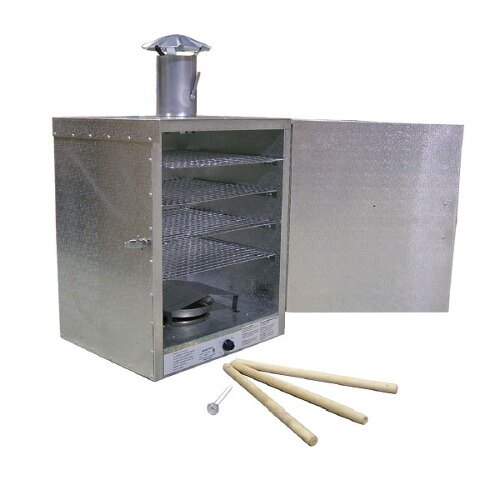 |
Unless you use liquid smoke or smoke salt in your “wurst”, which could then be finished in a regular oven, you might consider a smokehouse. Those you can buy from many big box retailers. Now the one I finally decided on is from the webstaurantstore.com. It is insulated and all aluminum and we used it also to heat up 40 pounds of roasted turkey breasts for a Thanksgiving dinner.
As I like to cold smoke my meat and sausage I build an exterior smoke generator to use with this unit, which I will write about some other time.
Back to the scales mentioned above, after a few years of working with a postal scale I decided to invest in a “Legal for Trade” scale and purchased the unit here, which comes in handy at our fundraisers and even for everyday cooking and baking.
Now besides stainless steel bowls and a dough scraper the only other item I can think of is a sausage pricker (linked above) to get the air out of the casing which might get trapped there during stuffing.
We covered the initial equipment of a grinder and stuffer for around $250.00 and the Tim Allen version for all the equipment for under $1700.00. It is up to you to figure out if your amount of usage justifies the added cost, for me it did!
We endorse Butcher & Packer Supply in Michigan as an excellent source to get your supplies.
Much of the equipment featured here is the equipment we use.
If we link to Amazon.com and you buy through this link we receive a small commission.
There is at this time no commission coming to us from sales from any of the other businesses mentioned in our blogs.

Image linked from http://www.porkbeinspired.com
Boneless Pork Loins were on sale for $ 1.49 lb at one of our local supermarkets and while selecting a couple for me, a lady, which was actually older than I, from an independent senior complex (saw her get into the bus later), was looking at a package of boneless pork chops for $ 3.99 lb. So I had to point out to her that she could save quite a bit of money by buying the whole loin.
I am still kind of amazed that many people do not realize that the pork chops come from the pork loin. So I told her if she would throw half of the meat from the whole loin away she would still be money-wise ahead of the game.
After her realizing this fact she told me that she could not use that much meat, so I pointed out that
Did she buy one or the other? I am not sure as I walked away when our conversation ended. So if you ever see these boneless Pork Loins on special, figure what you out could do with them and compare the price of these items already cut in the counter. Add it up, it is simple math.
In closing let me refer you to our recipe site Inge’s Kitchen and the pork section in Main Dishes and you will see that this piece of meat is terrific for a variety of Schnitzel, Roasts, Stews and I even use it for my extra lean, special “Head Cheese” when the price is right.
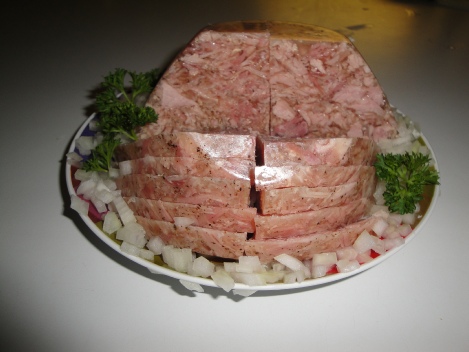
Suelze
Click here to see the definition of Peameal Bacon on Wikipedia.
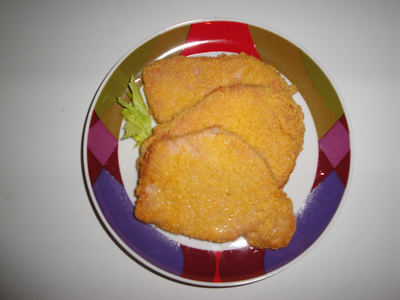 When we received the peameal bacon in our store we always sliced it thin and rolled the slices in cornmeal, that our customers get a nice crust when they fried them.
When we received the peameal bacon in our store we always sliced it thin and rolled the slices in cornmeal, that our customers get a nice crust when they fried them.
With boneless center cut pork loins well under the $2.00 mark again it is time to buy and cut up one of them.
Roasts, pork chops and even pork stew can be easily cut for a much cheaper price than in the meat counter. This is also the time to cut some thin slices and make some peameal bacon.
Sunny side up eggs or over easy with a couple slices of crispy peameal bacon and toast and jelly – what a great way to start a day.
If your pantry contains some cornmeal, the only ingredient you need, that you might not have in your house, is pink cure or DQ Curing Salt, which can be ordered from a supplier like Butcher and Packer Supply Company in Michigan.
For the easy recipe go to our Inge’s Kitchen website. Once you bought the curing salt, also check out our base recipe for Wurst to make a high quality lunch meat for the price of a pork shoulder butt. (It’s time to make the sausage when the pork butts are on special!)
Also see the post “Why waste Time to make Wurst?” for some IMHO pretty good reasons! .
As the definition of Corned Beef is already explained at Wikipedia there is no need for me to go into this. Let me also restate that this post presents my taste and my opinion and that I do not have any financial gains from it.
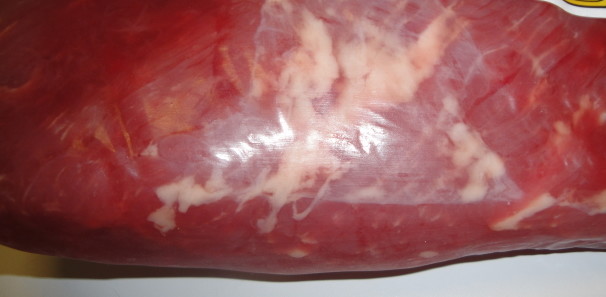 As St. Patrick’s Day is here again many of our taste buds are craving for our annual Corned Beef pilgrimage.
As St. Patrick’s Day is here again many of our taste buds are craving for our annual Corned Beef pilgrimage.
Looking through the meat counter nowadays it always amazes me how all the former “cheaper” cuts are now right up there in price with the steaks. Beef shanks, oxtails, short ribs, skirt steaks and all those nowadays fancy chuck cuts used to be the affordable beef dishes. Among these was also the beef brisket. As these cuts were harder to sell we cut some into stew or use them up in Hamburger. In the case of briskets we placed them in a saltwater cure and cooked them to sell as sandwich meat.
To speed up the process at commercial processors the meat was injected with the brine and ready to be sold in a couple of days. Naturally if the meat would retain more of the water in the brine the profits would be much larger.
Read the package label as the success story here is right on it: Contains up to 40% added water. I think it does not take a math genius to figure this one out.
Back to the hype of St. Patty’s Day. Every meat department is promoting corned beef briskets this week with many samples given out, especially with the ready to eat kind.
A sample from one of the well known manufacturers was 80% bun, raw Sauerkraut any decent Bavarian would consider way below standards and a little bit of corned beef you could not even taste; Good Job trying to sell your product or as Clara said: Where is the Beef?
The Sauerkraut: A decent Sauerkraut should be drained, washed and cooked for at least a couple of hours and has to have onions and diced Bacon added (see our recipe at Inge’s Kitchen), which is by Kosher standards impossible.
If we find a corned beef brisket at the right price during the year we have a boiled dinner occasionally. Usually you have to at least double the poundage you buy as they shrink heavily while you cook them.
Deciding to join the crowds and have a traditional Detroit area St. Patty’s Day dinner, boiled with potatoes, cabbage, onions and carrots added to it the last hour, I wanted to go the extra mile (actually 40 miles round trip) and buy the right stuff.
So for our weekly coffee outing my butcher friend Steve and I went to the Gratiot Central Market just outside of the Detroit Eastern Market.
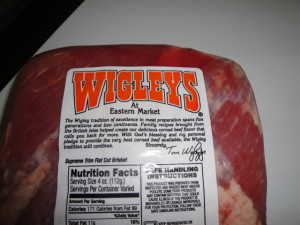 Wigley’s Corned Beef is, IMHO, one of the best corned beef suppliers around. Even if the package has the same water added statement as all the other brands, this piece of meat did not shrink down to nothing. The taste was very mild, salted just right and if sliced properly against the grain it could be cut with a fork while still retaining a “bite”**.
Wigley’s Corned Beef is, IMHO, one of the best corned beef suppliers around. Even if the package has the same water added statement as all the other brands, this piece of meat did not shrink down to nothing. The taste was very mild, salted just right and if sliced properly against the grain it could be cut with a fork while still retaining a “bite”**.
I bought enough for one meal for us on Sunday and to my surprise we ended up with enough leftovers for a second meal on St. Patty’s Day itself.
** A “bite” is very important to me, it is something to chew, like a kielbasa made from meat, without all the soy products and other fillers. As an example, if I want an apple to bite into I expect a “bite” not apple sauce!
With all my years working in the food industry I came across some real asinine decisions coming from our regulators.
When labeling our food we now have to list all ingredients with allergens separate, so when picking up a carton of eggs, the ingredient list actually states contains eggs. A package marked Wheat Flour actually lists allergen: Wheat. Peanut Butter really has peanuts on the allergen list and even the carton of milk has, you guessed it, contains milk on the label.
The list goes on and on with obvious examples. I can see that in some cases listing allergens are important and will protect the few of us with these allergies, especially if they are life threatening.
Now here is another one. There are cans that are cooked to a specific temperature that do not need an expiration date on it. This reminds me of the “Gourmet” (LOL) canned rations the US Army served us in the 70’s that were still Leftovers from World War II. But now if you produce cans under the same procedures mentioned in this paragraph and have a larger production run (make more cans), they have to have an expiration date on it. Duh!
The best one of them all:
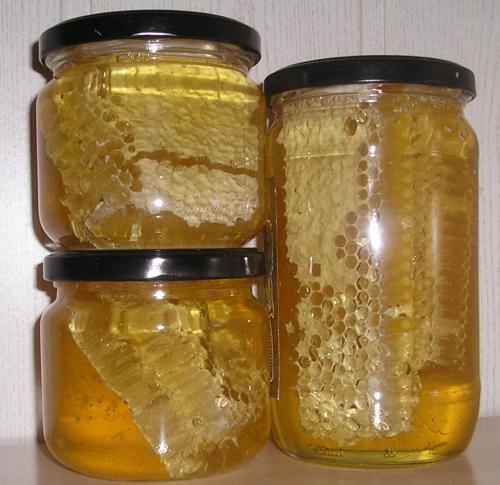 There is a food that does not spoil. They found it in the tombs of the pharaohs and it was still edible (between you and me, I would not have wanted to be the one eating it!). It is HONEY! (see the article at the Smithsonian.com).
There is a food that does not spoil. They found it in the tombs of the pharaohs and it was still edible (between you and me, I would not have wanted to be the one eating it!). It is HONEY! (see the article at the Smithsonian.com).
Yes, every jar of Honey I look at has an expiration date on it!!
Hamburger Versus Ground Beef:
According to the USDA: Beef fat may be added to “hamburger,” but not “ground beef.”
They both can contain up to 30% fat. Where does the fat come from in the ground beef if you are no allowed to add it?
And it is getting worse as time goes by. After I sold my store I heard stories where the inspector finding a minor violation was not worried much about what was done to correct it, but only concerned that the proper paperwork was filled out.
I know of one of our states that in order to vacuum pack items when a customer asks, there has to be a procedure filed on how it is done and every time you do it, it has to be recorded, making this service almost too cumbersome.
While we ran our store our inspection reports were always great, with just minor infractions, like storing a ladder behind the door in one of the bathrooms, but hearing about all these unnecessary changes makes me glad that I do not have to put up with them anymore.
I remember that smoking was allowed in food stores, which is unthinkable nowadays, but now a saw people bringing their dogs (pets, not working dogs) into stores that sell food, that seems to really be an improvement in the laws, dog hair all over the merchandise and the occasional accident on the floor.
In my time in the business I came across many more of these tidbits and I will add them as I can think of them, if they are appropriate.
And it seems that all those lawyers in Washington (I think there are way too many) have too much time on their hands and come up with more and more of these “…….” rules and regulations. I admit a few of them are to our benefit, but many just cost us more of our hard earned money!